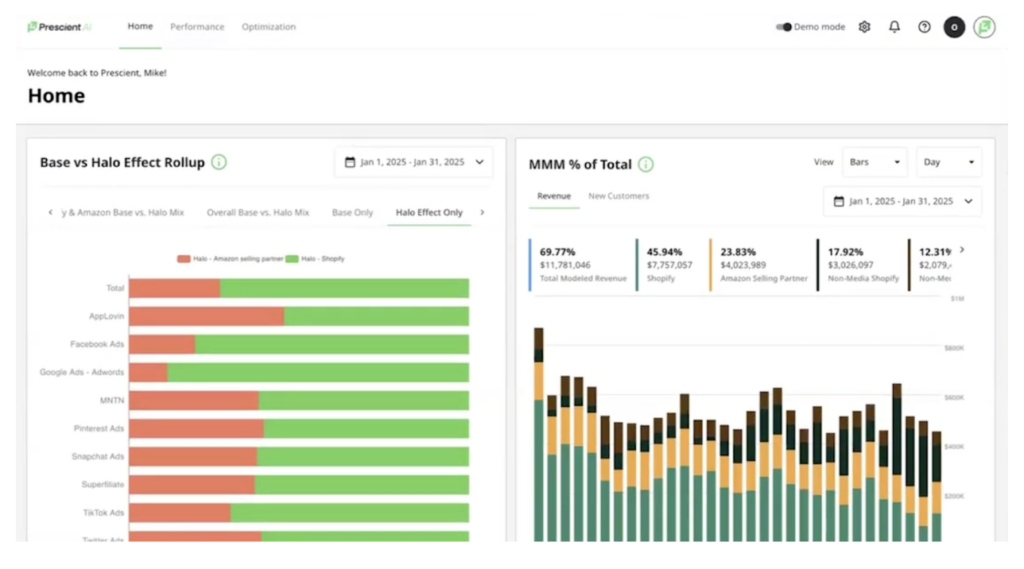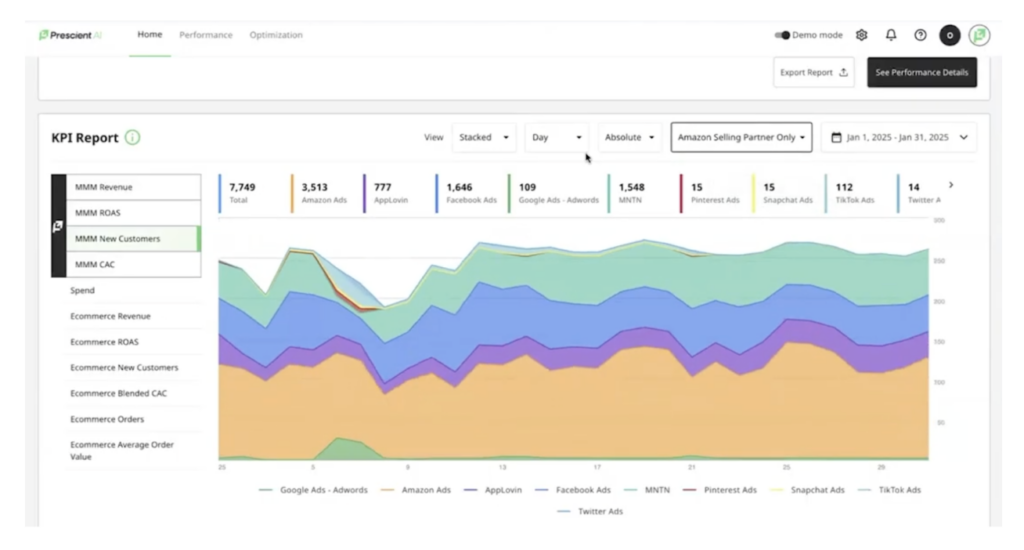I use Prescient AI every day with my growth team. But, it has come to my attention that some of you are still forecasting the old fashioned way. That ends now.
I can’t teach you about the subject alone. In fact, I don’t want to. Today’s guest, and my friend, Michael True (CEO of Prescient AI) has created the most powerful MMM on the market.
He also has the world’s cutest dog, Rio (Rio is bilingual!!!). When you demo with Mike, I’ll make sure to have him bring Rio – makes all the difference.

I met with Mike (and Rio) live – and here’s what you need to know about forecasting, MMM, and predicting growth – in Mike’s own lightly-edited words, with commentary in the 3rd person by me LOL.
PRESCIENT AI WAS BUILT FOR CARDI B.

WHEN SHE DROPPED HER SONG, UP, IN 2021, PRESCIENT AI PREDICTED THE STREAMS WITH 96.3% ACCURACY.
“When Cardi B is about to drop a song, there’s a ton of noise—paid ads, earned media, TikTok virality—but it’s tough to pinpoint where to put ad dollars for the best results. So, we partnered with a major record label. My co-founder, Cody—who I call the Michael Jordan of research science—and I dug into the data and built the model.
We analyzed past songs from Cardi B, Roddy Ricch, and others, tracking daily streams (like revenue) and ad spend. Then, we factored in viral moments. One example? A TikTok trend where kids recorded their parents’ reactions to a song—it drove about 5% of Cardi’s streams organically. That’s what we call a “halo effect.”
We built our model from scratch to quantify these effects and optimize ad spend. Looking at historical data, we figured out how we could have gotten more streams for the same budget by reallocating spend. In February 2021, when Cardi released Up, we tracked the numbers, and I’ll never forget when Cody called me. No tech platform yet—just Word docs and screenshots—but we predicted how shifting spend from Spotify to YouTube and Facebook to Snapchat would impact streams.
We were 96.3% accurate. That’s when I knew—it actually worked.
The next month, Apple announced iOS 14.5, shaking up digital advertising. Cody called me again and said, “We need to raise capital, hire research scientists, and turn this into a SaaS platform.” Our model wasn’t just for music; it was a game-changer for all marketers looking to scale top-of-funnel campaigns.”
Note from Ari (sorry for the 3rd person – stay with me): It’s now the world’s smartest ecommerce marketing decision engine. So, yes, I’m very glad they pivoted to ecom.
HOW BRANDS, AGENCIES, AND AD PLATFORMS DRIVE THE CHANGE OF MEASUREMENT

“When brands like Casper, Warby Parker, and AWAY first launched, they built their businesses largely on Meta and Google. Then, iOS 14.5 dealt a blow to platform reporting, so MTA (Multi-Touch Attribution) models stepped in with pixel-based deterministic measurement. The problem? To maintain growth, brands needed to expand beyond Meta and Google, adding channels like YouTube, MNTN, and Podscribe..
But, these native platforms weren’t designed to measure halo effects, and MTA focused too much on click-based journeys.
That’s when brands and agencies started looking to MMM (Marketing Mix Modeling) vendors to fill the gap—something we had been researching and building for years. Here’s the truth: there’s no single source of truth. Trusted data can drive decisions, but the marketer is the ultimate source of truth.
Different tools serve different needs—it’s about triangulation, using multiple data points to guide strategy.”
Note from Ari: I use Motion for creative analytics, Northbeam or Triple Whale for MTA, and Prescient AI for MMM. This is my stack.
BTW, we need an MMM in our stack because it’s UNBIASED. It uses a brand’s own data to train the models for historical input. Meaning it’s always evolving as the business/ brand grows and changes. The model gets stronger over time and Prescient AI uses years of historical data from your own brand to train – 1 of the questions during onboarding is literally, “Does your brand have at least 2 years of historical data that we can use?”
WHEN TO EXPAND FROM ONLY USING GA4, PLATFORM DATA, AND AN MTA

“Brands often come to us saying, “We turned this campaign on and off, but I have a feeling our Meta ads are driving Amazon sales—I just can’t prove it.” When there’s a lack of confidence in how top-of-funnel spend impacts broader sales, that’s when they start looking for answers.
But MMM isn’t always the right move immediately. If you’re on Shopify with just a couple of channels, we usually recommend starting with MTA. Once you hit 4, 5, or more channels—especially if you’re moving beyond DTC into Amazon—getting data into these models early helps you test and learn faster.
When you’re scaling top-of-funnel, that’s when MMM becomes a gamechanger.”
Note from Ari: When my team 1st started using Prescient AI, we had our hand held WEEKLY by Paul Powers (our account manager at Prescient AI). He still, to this day, builds our Optimizers for us and guides us through the data and what to do next. He gave us his phone number in the 1st meeting, if that says anything (to me, it says everything).
HOW MMMs EVOLVE AND THE HISTORY
“Back in 1962, when someone sold gum in a retail store, they ran ads—but they had no way to track exactly how those ads led to sales. So, early marketing mix models (MMMs) were built for long-term budget planning. With only a few channels—radio, TV, newspapers, billboards—data scientists collected as much time-series data as possible, running the model once a year to allocate budgets.
Then the internet changed everything. Suddenly, you could track users across the web, and deterministic models took over. When Amazon, DTC, and social media exploded, brands started buying directly from platforms, relying on MTA (and platform measurement) instead of traditional MMMs.
But there was still a gap. Traditional MMMs—like Nielsen’s—cost a million bucks a year, delivered a PDF report, and only gave insights at a single point in time.
We asked: What if MMMs ran every single day?
So, we built a model that updates daily—not just at the channel level, but at the individual campaign level. It tracks saturation, diminishing returns, and allows for rapid iteration.”
Note from Ari: The model runs every single day, so we check it every single day. Even the best MTA runs 1x a month, every 3 days. That’s why we need Prescient AI in the stack – for accuracy.
REAL TIME INCREMENTALITY

“There’s a qualitative and quantitative side to this. Qualitatively, marketers need to scale channels and find new audiences, but many don’t feel confident in testing top-of-funnel strategies—especially when measurement feels uncertain.
That’s where our optimizer comes in. Quantitatively, it analyzes historical performance based on your current spend. We create a baseline forecast—if you keep spending the same, here’s what your revenue, ROAS, CAC, and new customers will look like. Then, using proprietary machine learning, saturation plots, and halo effects, we determine exactly how much to spend on each campaign to drive incremental growth.
It’s a real-time, dynamic way to run incrementality tests—allowing brands to make data-driven decisions across Shopify, Amazon, and even Retail.”
Note from Ari: The budgets for the Optimizer are based on 14 days of historical data average. So it’s not that you need to know exactly what you’re going to spend – it looks back at what you did. And that’s how you judge the foundation.
WHAT TO DO NEXT
HexClad, Jones Road Beauty, Coterie, GRAZA, and Cardi B’s record label proudly use Prescient AI. As do I.
I think that if you have any stress, anxiety, or fear around forecasting – then this is your sign to stop doing something by hand that should be done by scientists. I won’t lie to you, I rock at excel. Google sheets are my thing. I also was a Religious Studies major who did not train my entire life to be a data scientist. That’s why I don’t allow myself or my team or anyone to do by hand what Prescient AI can do with robots. I trust my team, and myself, to take that information and to find truth.
Basically, I haven’t felt more confident about growth and hitting our numbers since I was traveling with my AWAY suitcase and sleeping on my Casper mattress in 2020. We’re in a new era, and it’s a good 1 if we use the tools at our disposal. I’ve since switched to Rimowa and Eight Sleep – again, I like this era.
Meet Rio. Meet with Mike. Ask me any and every question you have about forecasting. If I don’t know the answer, I’ll bring in someone or something smarter than me to help.
Book a meeting with Mike and Rio and my team at Prescient AI. Ask for Paul Powers once you sign on. Mike, I didn’t ask you if I could send everyone to Paul, but we need Paul.


